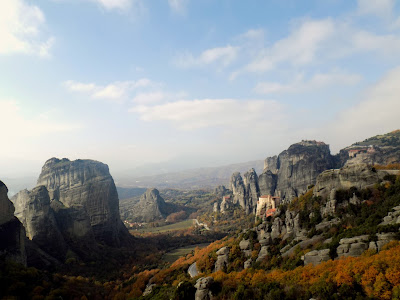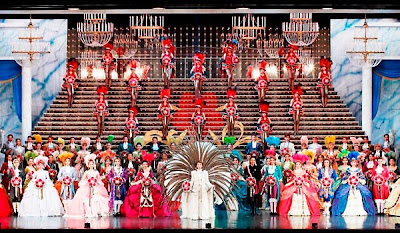A month in Greece: Meteora
 |
| Climbing to Greek monasteries in Meteora |
In 2016, I spent about a month traveling through mainland Greece with Anna. We left the U.K. mid-November and returned just before Christmas. During our stay in Greece, we visited Meteora, Thessaloniki, Kalamata and the Peloponnese Region and Athens. I'll be posting a short series on those places over the next couple of weeks.
First of all, I have to say that Greece was amazing. Everywhere we went was beautiful and full of history and the food was incredible. Especially the bakeries. If you ever get the chance to try Greek food, do yourself a favor and have some baked goods. Of course, the salads and fresh produce are also great, as are the gyros - if you're not familiar, they're a kind of pita wrap with things like meat, tomatoes, cucumber, tzatziki (yogurt and cucumber sauce), and some places even stuffed a few fries in as well.
 |
| On the left is a Greek salad with Feta tomatoes, olives & cucumbers. Right is a kind of build your own gyros. |
 |
| Two of the most beautiful baked goods I have ever had the luck to behold |
I could go on about the food for a long time, but I will try to restrain myself. (Besides, talking about the amazing qualities of Greek food when I can no longer eat it every day is depressing me.)
We arrived in Athens and the very next day caught a train out to the small city of Kalambaka in central Greece. It took us about half a day to get there, but the train ride passed through some really beautiful areas.
Meteora is the name of a UNESCO World Heritage site located between Kalambaka and the little town of Kastraki. Between the two towns is a large plateau like area with incredible rock formations, huge cliffs with unbelievably beautiful views of valleys and the Greek countryside, and perched on the top of the rocks are six Orthodox monasteries and convents.
 |
| An Orthodox convent perched up on the cliffs in Meteora, Greece |
I grew up Eastern Orthodox Christian, so visiting the monasteries in Meteora brought back a lot of mixed feelings for me, reminding me of all the things that I love and hate about the Orthodox tradition. Overall though, I'm really glad that I went - the monasteries we visited were so beautiful and it would be worth a visit just for the artwork alone. The primary churches inside the monasteries were covered in icons, some dating as far back as the Byzantine period. I've always really loved icons. I find the style of the art very powerful because of its simplicity.
We visited three of the six monasteries that still exist in Meteora. The first was one of the smallest, the St. Nicholas Monastery. Despite being small, it had one of the most beautiful churches within it of all the ones I saw in Greece. The precipice that it is perched upon was first inhabited by rock-climbing hermit monks as early as the 14th century. The monastery was built in 1510 and has some of the most important iconography in Meteora, some of which was painted in 1527 by a famous monk called Theophanes Strelitzas.
 |
| The interior of the church in St. Nicolas Monastery in Meteora. (Photo credit) |
The patron saint of the monastery was, of course, St. Nicholas, who seemed to be very popular in that region of Greece. If you're not familiar with the actual person St. Nicholas, who later became the inspiration for Santa Claus, he was a bishop of the Orthodox Church in the 4th century AD. He was the bishop of Myra, which is located in modern day Turkey. He was also on the council of 12 bishops that govern the Orthodox church (which does not have a single leader, like the Catholic Pope.)
 |
| An icon of St. Nicolas, who later inspired "Santa Claus" |
Next we visited Varlaam, which you can either follow the road up to or you can take a hiking trail that starts from the highway that leads up to the monasteries. It's relatively easy to find. To get to Varlaam Monastery, just keep to the right on the trail. We hiked up and it only took about 30 minutes; the trail was not especially difficult.
On our way up, we saw something being lowered down from the monastery by rope, which was originally how everything (including people) used to enter and exit the monasteries in Meteora. Apparently the monks didn't believe in replacing the ropes until they broke, trusting that God would protect them (or not) as he saw fit.
 |
| Something being lowered down by rope from Varlaam Monastery in Meteora, Greece |
Varlaam was under some construction when we visited, but it was still really nice and had some more interesting features than the little St. Nicholas monastery. You could wander into their original wine store room, where there is a wooden vat for storing wine about the size of a minivan. An old kitchen was set up to look the way it would've historically. Varlaam also had a museum that described the history of the monastery and offered a good explanation of some of the basic aspects of Greek Orthodoxy for those who aren't so familiar with it.
 |
| Varlaam Monastery in Meteora, Greece |
 |
| The car-sized wine barrel, because Orthodox monks have priorities |
 |
| Old-fashioned kitchen on display at Varlaam Monastery in Meteora |
The last one we visited was the Great Meteora Monastery. It is the largest one and is quite impressive. The church inside it was amazing - it was very big compared to the others we saw in Meteora, and the artwork was beautiful. Like Varlaam, it offered little glimpses into the history of the monastery with an old kitchen on display, a museum housing some truly amazing icons, and of course another monstrous barrel for storing wine. It also had a tiny room where the relics (ie skulls and bones) of former monks and priests were kept.
 |
| Relics of former monks at Great Meteora Monastery in Meteora, Greece |
 |
| Great Meteora Monastery, the biggest of the 6 active monasteries in Meteora |
Unfortunately, Great Meteora was also the most crowded, which really took away the feeling of seclusion and isolation from the world that you would expect to feel when inside a monastery.
If you're not very interested in visiting religious sites, or just looking for something to do in between visiting monasteries, just walking along the side of the road that climbs up to the cliffs is a worthwhile experience on its own. The views from along the road are absolutely stunning. There were a number of places where you could stop for awhile to take pictures or just relax and enjoy the scenery. Also, there were tons of little trails all over the place - we wandered off the road a few times, not really knowing where the trail was taking us, and discovered some of the old monk's caves that we could wander through.
 |
| Looking down at St. Nicolas Monastery |
 |
| Gorgeous fall weather and scenery in Meteora in November |
 |
| Exploring the inside of a monk's cave |
I've heard that Meteora can be really crowded now if you go in the peak season, so I really recommend going in the off season if you can. It was really beautiful when we were there in mid-November. The fall colors really added a magical quality to the already fantastic landscape. And the weather was sunny and warm without being too hot, perfect for hiking.
There are great hostels in both Kastraki and Kalambaka. Kalambaka is a little bigger and has a lot more going on in terms of nightlife and restaurants. We stayed in Kastraki and personally I really preferred it. It was much quieter and gave us the feeling that we were staying somewhere rural and genuinely "Greek". The hostel we stayed at was called Zoza's Rooms, and I can't recommend it enough. The people running it were really friendly and both the room and the breakfast were great.
 |
| View from our room at Zoza's Rooms in Kastraki |
 |
| Lovely fresh breakfast at Zoza's Rooms in Kastraki |
Of all the places I visited in Greece, I think Meteora topped my list. It is such an unusual place; you can see why the monks chose to sequester themselves there. The beauty of the landscape really makes you want to stop and just take a long moment to appreciate the wonder of nature.
 |
| Anna taking a good long moment to appreciate the spectacular scenery in Meteora |
More posts about Greece:


Comments
Post a Comment